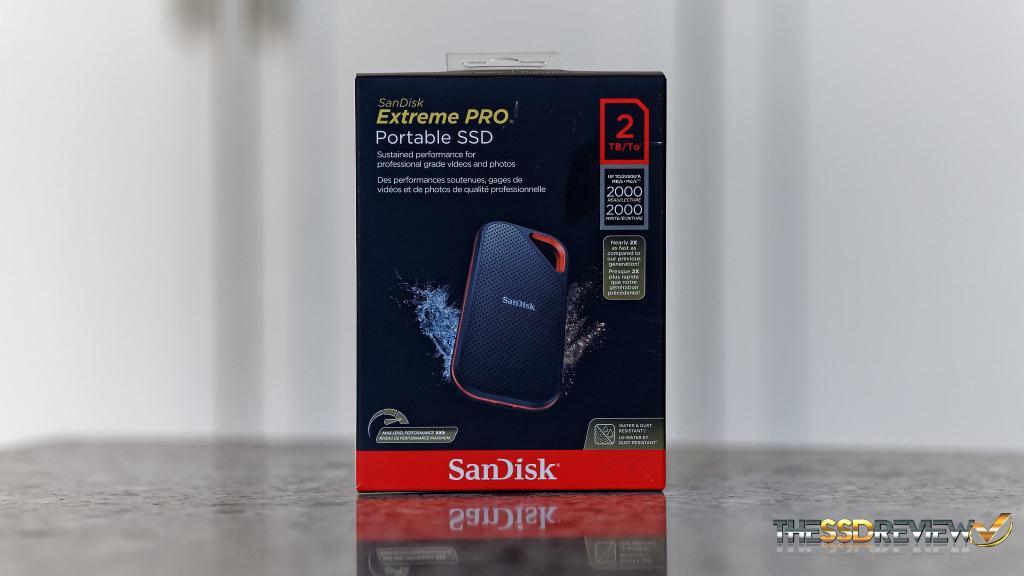I didn’t know that! We might bet you will be saying that on conclusion of this report as, for some reason, USB 3.2 Gen 2 20Gb/s is being overlooked by the storage industry. The industry standard for all that is consumer portable storage speeds has settled at USB 3.2 Gen 2 10Gb/s (1GB/s transfer speed) while the ‘Feast Du Jour’ for media professionals is Thunderbolt 3 which bumps up throughput to a blistering 2.8GB/s.
In between those two lies USB 3.2 Gen 2×2 20Gb/s which has performance of 2GB/s, is not at all compatible with Tbt 3, and is rather hard to find in preconfigured PCs, laptops, ultrabooks as well as on motherboards themselves for system builders. Take a look at the exterior packaging of the SanDisk Extreme Pro Portable SSD we are reviewing… read and write performance of 2000MB/s. This is one of very few devices of this performance point that you will find available today. Perhaps we are about to see USB 3.2 Gen 2×2 as the new industry standard. Are we seeing the successor to Thunderbolt 3?
The SanDisk Extreme Pro Portable SSD is USB 3.2 Gen 2×2, is available right now in a 2TB capacity with and has MSRP of $499.99, a 1TB version expected to also be available in the near future with a MSRP of $299,99, It comes with 256-Bit AES Hardware encryption, a 5-year warranty and has IP55 dust and water resistance with a 2 metre drop rating.
But wait!!! It has a $499.99 MSRP but Amazon has it on sale right now for $299.99. Check here!
The Extreme Pro V2 is constructed of a solid aluminum chassis that serves as a heatsink for the WD SN730 NVMe M.2 SSD inside. Its shape displays a carabiner style loop soft rubber base with smooth rubber top and probably the only thing we think might benefit this more is the inclusion of a matching orange aluminum D-ring. Inside the packaging, we find the SanDisk Extreme Pro V2 Portable SSD itself, a Type-C to Type-C cable, Type-C to Type-A cable and a user manual.
Similar in appearance to the just released SanDisk Extreme Portable SSD that we reviewed here, both are fully Windows and Mac compatible and both can be connected to your PC or laptop via Type-C connector or USB 3.1 Type-A. The difference of course, is that the Extreme Pro on the left gets you 2GB/s read and write data throughput while the Extreme Portable pulls in half that. Just as important to mention, however, is that there are a myriad of systems and laptops that will accommodate the Extreme Portable on the right, whereas not so many for the Extreme Pro.
Crystal Disk Info is a great tool for displaying the characteristics and health of storage devices. It displays everything from temperatures, the number of hours the device has been powered, and even to the extent of informing you of the firmware of the device.
Taking a look at Crystal Disk Info, we can validate that the SSD inside is the SN730E, this SSD is NVMe and using the NVMe 1.3 protocol.
ATTO Disk Benchmark is perhaps one of the oldest benchmarks going and is definitely the main staple for manufacturer performance specifications. ATTO uses RAW or compressible data and, for our benchmarks, we use a set length of 256mb and test both the read and write performance of various transfer sizes ranging from 0.5 to 8192kb. Manufacturers prefer this method of testing as it deals with raw (compressible) data rather than random (includes incompressible data) which, although more realistic, results in lower performance results.
ATTO results hit performance bang on at 2GB/s read and write, with a very steady speed progression while sample size increases.
 The SSD Review The Worlds Dedicated SSD Education and Review Resource |
The SSD Review The Worlds Dedicated SSD Education and Review Resource | 


Fairly soon you will be reviewing the SanDisk Extreme Pro ‘Super Speedy’ Portable SSD when it comes out with USB4, capable of 40Gb/s. Thankfully we won’t see .1, .2 etc. as they are doing away with the version numbers.
Also USB4 and Thunderbolt 3 will start to become compatible with each other. A quote:
“Compatible With Thunderbolt 3 Optionally
Intel made news when it said it had given the Thunderbolt 3 protocol to USB Promoter Group, allowing devices with USB4 ports to potentially be compatible with Thunderbolt 3 devices and USB4 devices to attach to Thunderbolt 3. That’s good news for everyone, especially laptop users who want to play games by connecting an eGPU (external graphics card).”
Hopefully connectivity will become much more standardized, but I doubt it.
SanDisk sure has been busy bringing us new and excellent products. thanks for the review Les.